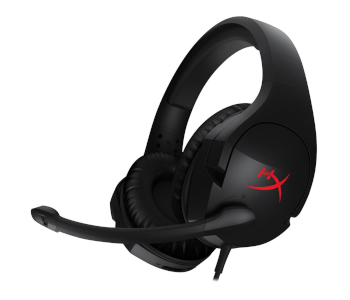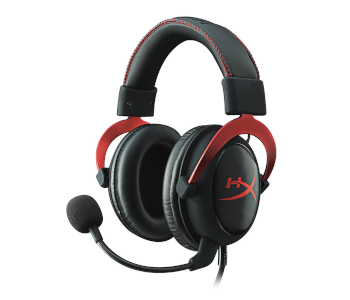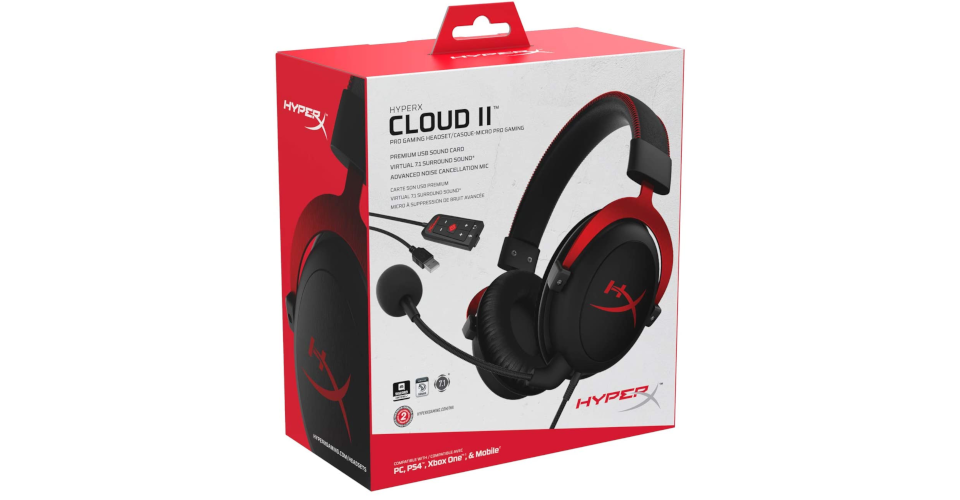Headphones Comparison: HyperX Cloud Stinger vs. HyperX Cloud II
HyperX is one of the most popular brands of gaming headsets, with the company offering a wide range of wired and wireless headsets. The Cloud Stinger and the Cloud II are two of the best headsets in the current HyperX lineup. The latter is the more expensive product, normally selling for around $100, while the former sells for half the price.
If you have narrowed down your choices to these two gaming headsets but can’t decide which one is the better buy, especially considering their similarities in several aspects, we’ll make things easier for you. In this head-to-head comparison, we’ll highlight the strengths and weaknesses of both products to help you make a more informed decision in the end.
Quick Look
| HyperX Cloud Stinger | HyperX Cloud II | |
|---|---|---|
| Form Factor | Over-ear | Over-ear |
| Enclosure Type | Closed-back | Closed-back |
| ANC | No | No |
| Connectivity | 1/8 in (3.5 mm) analog | 1/8 in (3.5 mm) analog, USB |
| Battery | N/A | N/A |
| Weight | 9.7 oz | 11.3 oz |
| Price | Amazon | Amazon |
Design
The Cloud II is a better-designed gaming headset than the Cloud Stinger, besting the latter in many design aspects. Its overall build quality is better, boasting a sturdier build with more metal parts and a more durable audio cable. It offers more controls and has more accessories, including an additional pair of earpads. Furthermore, it’s available in more color options and has a more casual design that some people might prefer. The Cloud Stinger is better in a few areas, though. In addition to being lighter, it has more convenient on-cup controls and features rotating ear cups for easier storage.
Fit
The Cloud Stinger and the Cloud II are bulky gaming headsets featuring closed-back ear cups for passive noise isolation. Both are suitable for long gaming sessions. Their ear cups and headbands are both well-padded, with their spacious ear cups capable of accommodating most ear sizes. Both are also decently breathable for closed-back headsets but have relatively tight headband clamps, which can be uncomfortable if you have a large head. If their respective audio cables are too short for you, they can be extended using the Y splitter cable for the Cloud Stinger and the USB cable for the Cloud II.
While both headsets are comfortable to wear for long hours, the Cloud II is more comfortable overall despite being the heavier headset. It comes with an additional pair of velour earpads that are more breathable and feel nicer on the skin than the default leatherette earpads. Additionally, its headband is more generously padded, but not by a significant margin.
Build

Featuring a sturdier metal frame, the Cloud II is better-built than the Cloud Stinger. It has metal yokes and durable plastic ear cups and includes a more robust braided cable. Its earpads and headband padding are both made of soft memory foam covered with leatherette, with the headband featuring a nice stitched design. Unfortunately, the analog audio cable is non-detachable, which makes it harder to replace when damaged. On the plus side, the boom mic, which connects to the left ear cup and has a more flexible arm, is removable.
The Cloud Stinger also has a decent plastic build for a budget headset and feels better-built than many other gaming headsets in the same price range. It has more plastic parts than the Cloud II, which makes for a lighter build. It has durable plastic ear cups and a plastic headband reinforced with a thin strip of metal for a sturdier build. Its earpads and headband padding are also made of soft memory foam with leatherette covers. But unlike the Cloud II, its audio cable is made of rubber and its boom mic is not detachable from the left ear cup. In addition, it has more moving parts vulnerable to wear and tear due to its rotating ear cups, with its hinges appearing to be the weakest spot in its entire build.
Regarding aesthetics, both headsets are not as flashy as other gaming headsets, with none of those RGB lighting systems that are more of a gimmick than a helpful feature. But while the Cloud Stinger has a simpler aesthetic due to its all-black color scheme, the Cloud II – which is available in red and gray colors – is the one that can be mistaken for regular headphones, but only when its mic is detached. Since its mic is always attached, the Cloud Stinger easily stands out as a gaming headset.
Controls
The Cloud Stinger has a more convenient control scheme for gaming. You can easily adjust the volume using the slider on the right ear cup, which is more convenient than using an in-line remote, especially when in the middle of a fast-paced game. Furthermore, its boom mic has an automatic mute function when swiveled upward, making it easier to tell if the mic is enabled or disabled, which can’t be said for some gaming headsets with a traditional mic mute switch.
On the other hand, the Cloud II has more controls, but only when the USB cable is used, as the default analog audio cable lacks an in-line remote. The USB cable – which seamlessly connects to the analog cable and terminates in a regular USB-A plug – has a small control box with separate controls for the game and mic volume levels, a dedicated button for toggling the virtual surround sound, and a mic mute switch. The control box is compatible with PC and PS4, but for the latter, you’ll need to check first if the USB dongle has the right firmware, as older versions only allow for full compatibility on PC.
Both headsets lack any form of controls for call and music management, which is a common omission among gaming headsets. This shouldn’t be an issue if you intend to use them strictly for gaming. But if you intend to also use them as headphones for everyday use – especially the Cloud II, which has a more casual design – the lack of a more mobile-friendly in-line remote can be inconvenient.
Portability
Like many other wired gaming headsets, both the Cloud Stinger and the Cloud II are not very portable. In addition to their bulky over-ear designs, they don’t fold into a more compact format to take up less space in your bag. The Cloud Stinger has more flexible ear cups that can rotate into a flat position, which makes it easier to store in your bag and less awkward to wear around your neck, but it lacks any form of storage. On the other hand, the Cloud II includes a soft pouch for travel, along with an airplane adapter, which is beneficial if you want to use them as travel headphones.
Accessories
The Cloud II has more accessories than the Cloud Stinger. It comes with a USB adapter, a soft pouch, an extra pair of velour earpads, and an airplane adapter, with the latter being an uncommon accessory for gaming headsets.
The travel pouch and airplane adapter, as mentioned, are especially beneficial if you intend to use the headset as travel headphones, while the velour earpads are useful if you don’t like the default leatherette earpads. Obviously, the USB adapter is the most useful among the accessories, as it allows for more controls on PC and PS4. The Cloud Stinger only includes a Y splitter cable for extending the audio cable and for connecting to separate headphone and mic ports on PC.
Performance
Unlike in the Design section, the Cloud II only holds a slim advantage over the Cloud Stinger regarding overall performance. It has a lower sound leakage and marginally better passive noise isolation and supports virtual surround sound. Its most notable edge, however, is its additional capability to connect to a PC or PS4 using the included USB cable. Regarding mic performance, the two headsets are about the same, though their mic designs are different. Their sound qualities are also good, but they sound different: the Cloud Stinger has a better treble and soundstage while the Cloud II has a better mid-range and a more accurate bass response.
Sound
Similarly equipped with dynamic drivers, the Cloud Stinger and the Cloud II are both good-sounding headsets that sound clear and detailed and have good imaging. Both their sound profiles can be described as balanced. However, most people will find the Cloud II more pleasant due to its bass not being overemphasized, but its treble can be piercing sometimes. It also supports virtual surround sound, but the implementation is not that good.
The Cloud Stinger has a smoother treble and a wider soundstage, with the latter being notable for a closed-back headset. But on the other hand, its overall sound is more bass-heavy, which is undesirable for some people. Unlike the Cloud II, it doesn’t support surround sound, which is hardly surprising for a budget headset under $50.
Both headsets are good for different kinds of games, including first-person shooters, rhythm games, role-playing games, and open-world adventure games. Sadly, you can’t modify their sound profiles for specific games, as both headsets lack a companion app for sound customization.
Isolation

With their closed-back ear cups, both the Cloud Stinger and the Cloud II provide decent passive noise isolation for gaming at home. Both are decent at reducing background chatter and high-frequency noises, with the Cloud II having a modest edge in both areas. But both are mediocre at blocking out low-frequency noises.
The Cloud II has a lower sound leakage than the Cloud Stinger and is one of the better closed-back headsets at keeping the audio from leaking out too much. This is beneficial when playing games at night with other people in the room trying to sleep, especially if you love to play action-packed first-person shooter games. The low sound leakage also means you won’t bother the people around you with your game audio when gaming on a handheld console or mobile device while on the go.
Mic
The boom mics of the Cloud Stinger and the Cloud II are both great for gaming, whether at home or in a tournament setting. Their recording qualities are both good while their noise reduction is superb, with the latter allowing for better voice pick-up even in a noisy environment. But while their boom mics are similarly great, their designs are different.
The Cloud Stinger has a non-detachable boom mic with a thicker and less flexible arm. You can easily mute it by swiveling it upward toward your head, which is convenient. If you need to use it for online multiplayer games, you can simply swivel it downward to enable it again.
On the other hand, the Cloud II has a detachable boom mic, which is a big plus for those who don’t really talk with other players through voice chat during online multiplayer games. The removable mic is also a plus if you intend to use the headset for non-gaming purposes with the mic detached. Unlike with the Cloud Stinger, the boom mic of the Cloud II has a windscreen, which helps with noise reduction and protects the mic from moisture and dirt. It also has a slimmer and more flexible arm. If the mic windscreen is damaged, you can simply replace it with third-party ones from online sellers.
Battery
Both headsets lack battery-powered features – like Bluetooth and active noise cancellation – and don’t need an internal battery to function. You can use them to play games as long as you want without worrying about running out of battery in the middle of a game.
Connectivity
The Cloud Stinger and the Cloud II are both limited to wired connectivity, with their non-detachable audio cables identically terminating in an analog mini-plug. You can directly connect them to a PC, handheld console, or mobile device. For gaming on PS4 and Xbox One, you’ll need to connect them to the controller itself. The Cloud Stinger also includes a Y splitter cable for separate headphone and mic ports on PC.
For gaming on PC and PS4, you can connect the Cloud II using the USB cable for the convenient in-line controls and for enabling the virtual surround sound feature. As mentioned in the Controls section, you’ll need to make sure the USB dongle has the right firmware for full compatibility on PS4 consoles. The USB adapter, which has a durable braided cable, is also useful for extending the length of the audio cable.
If you want the same setup for the Cloud Stinger – not only for more controls but also for the virtual surround sound feature – HyperX also offers a bundle that already includes a similar USB adapter, which normally costs around $20-30 more. But if you have no problem spending around $70-80 on a gaming headset, it’s much better to wait for the Cloud II to drop to that price range during a sale.
Unlike some wired gaming headsets such as the Corsair HS60 Pro and the Logitech G433, the Cloud Stinger and the Cloud II both lack a desktop app for customization. This means you can’t tinker with the mic settings or modify the sound if you don’t like the default tuning. While hardly a deal-breaker for most people, the lack of customization options is especially notable for the Cloud II, as there are other similarly priced headsets that offer a decent amount of customization through a desktop app.
Wrap-up
| HyperX Cloud Stinger | |
|---|---|
| The Cloud Stinger is one of the best budget gaming headsets under $50, with its good sound quality, great boom mic, and convenient on-cup controls being its most notable aspects. It’s comfortable to wear for long gaming sessions and has an analog audio cable for easy compatibility with different gaming platforms, including handheld consoles and mobile devices. While its build quality is not as good as that of the Cloud II, with fewer metal parts, it’s still better-built than many other gaming headsets in the same price range. Its ear cups can rotate to a flat position and provide decent noise isolation for gaming at home. If your budget is limited to around $50, the Cloud Stinger is one of the best gaming headsets that you can get, especially if sound quality, mic performance, and comfort are the most important aspects for you. | |
| Pros | Cons |
|
|
| HyperX Cloud II | |
|---|---|
| Often considered the best wired gaming headset under $100, the Cloud II is a great headset for gaming on both PC and consoles. It’s one of the few gaming headsets that gets it right in most aspects, with many people praising it for its good sound quality and sturdy build. It has an excellent boom mic and comes with a USB cable with an in-line sound card for more controls and for enabling virtual surround sound. Compared to the more affordable Cloud Stinger, it’s better-built, with more durable metal yokes, and comes with more accessories, including extra earpads. In addition, it has a more flexible boom mic, which is detachable, and provides slightly better passive noise isolation. It has a more casual design, too, which is a plus if you intend to use it as regular headphones. Overall, the Cloud II is the better product, especially if you want a sturdier and more durable headset. It’s one of the best gaming headsets currently out on the market, offering great value for the money. | |
| Pros | Cons |
|
|

